Tibetan Terrier
.jpg) | ||||||||||||||||||||||||||
| Other names | Tsang Apso, Dokhi Apso | |||||||||||||||||||||||||
|---|---|---|---|---|---|---|---|---|---|---|---|---|---|---|---|---|---|---|---|---|---|---|---|---|---|---|
| Origin | Tibet | |||||||||||||||||||||||||
| ||||||||||||||||||||||||||
| Domestic dog (Canis lupus familiaris) | ||||||||||||||||||||||||||
The Tibetan Terrier is a medium-size breed of dog that originated in Tibet.[1] Despite its name, it is not a member of the terrier group. The breed was given its English name by European travelers due to its resemblance to known terrier breeds.[2] The Tibetan name for the breed, Tsang Apso, roughly translates to "shaggy or bearded ("apso") dog, from the province of Tsang". Some old travelers' accounts refer to the dog as Dokhi Apso or "outdoor" Apso, indicating a shaggy or bearded working dog which lives outdoors.
History
The history of the Tibetan Terrier dates back thousands of years.[3][4] Tibetan Terriers were kept as good luck charms, mascots, watchdogs, herding dogs, and companions. They were also used to retrieve articles that fell down mountain sides.[5]
Also known as the "Holy Dogs of Tibet," Tibetan Terriers were never sold, only given as gifts by monks to promote good fortune. As such, the early history of the breed is linked to only a handful of foundation dogs. Recent DNA analysis has concluded that the Tibetan Terrier is descended from the most ancient dog breeds.[6]
Due in part to Tibet's geographical isolation, Tibetan Terriers were kept purebred for over 2000 years.[5] Monks and families referred to the ancient breed as "the little people", for they were highly valued as companions who were eager to assist in protecting properties and flocks. Since the dog was considered a bringer of luck, mistreating or selling a Tibetan Terrier was believed to cause bad luck to both family and village alike.
Dr. A.R.H. Greig of England brought the first Tibetan Terrier to Europe in 1922.[7] She was given a gold and white female puppy named "Bunti" after successfully performing an operation on a patient in Tibet. After acquiring a second male, "Rajah," Dr. Greig established a kennel and began to breed them.
The first litter was born in 1924 and were registered as Lhasa Terriers. In 1930, the Kennel Club of India changed the breed's name to Tibetan Terrier. The first Tibetan Terriers in the US were imported in 1956 by Dr. Henry and Mrs. Alice Murphy of Great Falls, Virginia. In 1973, the American Kennel Club recognized the breed, classifying it as part of the non-sporting group.[1]
Tibetan Terriers are related to and have contributed to the development of other breeds, including the Shih Tzu, Lhasa Apso, Tibetan Spaniel,[8] Polish Lowland Sheepdog,[9] among others.
Appearance
The Tibetan Terrier is a powerful, medium-sized dog of square proportions, with a shaggy coat. They vary widely in height and weight,[10] ranging from 14-16 in (35–41 cm) and is 18-30 lb (8–14 kg), with 20-24 lb (9.5–11 kg) preferred for either sex. All weights are acceptable if in proportion to the size. Fully grown, the Tibetan Terrier resembles a miniaturized Old English Sheepdog. The head is moderate, with a strong muzzle of medium length, and a skull neither rounded nor flat. The eyes are large, dark, and set fairly far apart. The V-shaped drop ears are well-feathered, and should be set high on the sides of the skull. Although the preferred colour for the nose is black, in showdogs, they are also sometimes brown. The body is well-muscled and compact. The length of the back should be equal to the height at the withers, giving the breed its typical square look. The tail is set high, well-feathered, and carried in a curl over the back. One of the more unusual features of the Tibetan Terrier is their broad, flat feet with hair between the toes, which are ideal for climbing mountains, acting as natural snow shoes.
The hair of the Tibetan Terrier has a long growth cycle. As a result, their coat grows quite long and pet animals will require occasional trimming.[11] They do not shed like dogs with shorter hair growth cycles, but rather slough hair at a rate similar to that of most humans. The exception is at approximately nine months when puppies slough their entire coat in advance of acquiring their adult coat. The double coat is profuse, with a warm undercoat and a topcoat which has the texture of human hair. It should not be silky or curled, but wavy is acceptable. Long and thick, it is shown natural, but should not be so long as to touch the floor, as is typical in breeds such as the Lhasa Apso or Maltese. A fall of hair covers the face and eyes, but long eyelashes generally prevent hair from getting in the Tibetan Terrier's eyes, and the breed has very good eyesight.
The coat of the Tibetan Terrier requires regular and careful grooming to keep tangles from forming. This coat helps the Tibetan Terrier withstand temperatures as low as -50 °C for prolonged periods of time.
All colours are permissible, barring liver and chocolate, and none is preferred. Gold is the rarest. Tibetan Terriers are available in any combination of solid, parti-color, tricolor, brindle, or piebald, as long as the nose leather is black and the eyes and eye rims are dark.[12]
 Tibetan Terrier
Tibetan Terrier Tibetan Terrier, white coat with red patches
Tibetan Terrier, white coat with red patches Tibetan Terrier
Tibetan Terrier Tibetan Terrier (7 months)
Tibetan Terrier (7 months) Cream coloured Tibetan Terrier. The tail is set high, well-feathered and carried in a curl over the back
Cream coloured Tibetan Terrier. The tail is set high, well-feathered and carried in a curl over the back Tibetan Terrier, black coat.
Tibetan Terrier, black coat. Tibetan Terrier puppy
Tibetan Terrier puppy
Temperament
The temperament has been one of the most attractive aspects of the breed since it was first established. They are amiable and affectionate family dogs, sensitive to their owners, and gentle with older children if properly introduced. As is fitting for a dog with origins as a watch dog, Tibetans tend to be reserved around strangers, but should never be aggressive nor shy with them. Though not prone to excessive barking, the Tibetan Terrier has an assertive bark.
Suitable for apartment living, the Tibetan is an energetic and surprisingly strong dog, and needs regular exercise. The energy level of the Tibetan is moderate to high and its general nature is happy, active, lively, intelligent, and agile. As a result, they are well suited for dog sports such as agility. They are steadfast, determined, and clever, which can lead to them being stubborn. Tibetan Terriers are usually charming and loyal. Some dogs of this breed can often be jealous, which can make it hard to live with another pet.
Activities
The Tibetan Terrier can compete in dog agility trials, obedience, rally obedience, showmanship, flyball, tracking, and even herding events. Herding instincts and trainability can be measured at noncompetitive herding tests. Tibetan Terriers that exhibit basic herding instincts can be trained to compete in herding trials.[13]
Health
A UK Kennel Club survey puts the average lifespan of the breed at 12 years. About one in five lives to 15 years or more, with the longest-lived Tibetan Terrier having lived to 18.25 years.[14]
Though an athletic breed that has been bred for a natural look, the Tibetan Terrier is nonetheless susceptible to a variety of health problems, especially those related to the eyes and joints.[15] These problems can include canine hip dysplasia, luxating patella, progressive retinal atrophy, lens luxation, cataracts and heart murmurs. Tibetans also have a history of being somewhat allergic to dairy, wheat and grains. Because of these potential health conditions Tibetan Terrier clubs recommend purchasing from breeders who participate in eye and hip testing, such as the Canine Eye Registration Foundation (CERF) and Orthopedic Foundation for Animals (OFA).
In addition, Tibetan Terriers can carry the genetic disease canine neuronal ceroid lipofuscinosis, called Batten disease in humans. The first symptom of the disease is night blindness. Blindness and neurological signs such as epilepsy, motor abnormalities, dementia, and unexpected aggression will follow some years later.[16] The gene responsible for the disease in Tibetan Terriers was identified in 2009 and there is now a DNA test for it.[16][17] A German study showed that about 1/3 of Tibetan Terriers are carriers, but no affected dogs has been produced since the introduction of the DNA test as the German breed club requirements forbid carriers from being bred together.[16]
See also
- Dog of Osu
- Tibetan dog breeds
- Tibetan kyi apso
- Lhasa Apso
- Tibetan Mastiff
- Tibetan Spaniel
- Index of Tibet-related articles
| Wikinews has related news: Four new breeds in the Westminster Kennel Club Dog Show |
References
- 1 2 American Kennel Club (2013). Get to know the Tibetan Terrier. Retrieved from http://www.akc.org/breeds/tibetan_terrier/index.cfm
- ↑ GotPetsOnline.com (2013). Tibetan Terriers. Retrieved from http://www.gotpetsonline.com/pictures/gallery/dogs/terrier-dogs/tibetan-terriers/
- ↑ Pure-bred Dogs, American Kennel Gazette, Volume 105, p.135, American Kennel Club
- ↑ The Auburn Veterinarian, Volumes 28-30. Student Chapter of the American Veterinary Medical Association. 1971. p. 39.
- 1 2 Tibetan Terrier Club of America (2012). About the Breed: History. Retrieved from http://ttca-online.org/html/history.html
- ↑ Ostrander, Elaine A. (2007). "Genetics and the Shape of Dogs". American Scientist. 95 (5): 406. doi:10.1511/2007.67.3724.
- ↑ Reif, Jane (1996). The Tibetan Terrier book. Southfarm Press. ISBN 0-9672628-0-1.
- ↑ Pugnetti, Gino. Simon & Schuster's Guide to Dogs. Simon & Schuster. p. 121.
- ↑ Dogs All-in-One For Dummies. Wiley. p. 532.
- ↑ Wikerd, Marjorie (2011). "Non-Sporting Group: Tibetan Terriers". AKC Gazette. American Kennel Club. 128 (3): 70.
- ↑ Purina (2013). Breed Library: Tibetan Terrier. Retrieved from http://www.purina.com.au/owning-a-dog/dog-breeds/Tibetan-Terrier
- ↑ American Kennel Club (2013). Tibetan Terrier: Breed Standards. Retrieved from http://www.akc.org/breeds/tibetan_terrier/breed_standard.cfm
- ↑ Hartnagle-Taylor, Jeanne Joy; Taylor, Ty (2010). Stockdog Savvy. Alpine Publications. ISBN 978-1-57779-106-5.
- ↑ "Individual Breed Results for Purebred Dog Health Survey".
- ↑ Discovery Communications, LLC. (2013). Animal Planet Tibetan Terrier Guide: Care and Health Retrieved from http://animal.discovery.com/breed-selector/dog-breeds/non-sporting/tibetan-terrier.html
- 1 2 3 Kluth, S.; Eckardt, J.; Distl, O. (2014). "Selection response to DNA testing for canine ceroid lipofuscinosis in Tibetan terriers". The Veterinary Journal. doi:10.1016/j.tvjl.2014.05.029.
- ↑ http://www.offa.org/dnatesting/ncl.html| administered by the Orthopaedic Foundation for Animals (U.S.A.)
External links
| Wikimedia Commons has media related to Tibetan terrier. |